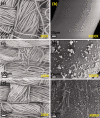Using visible light to activate antiviral and antimicrobial properties of TiO2 nanoparticles in paints and coatings: focus on new developments for frequent-touch surfaces in hospitals
- PMID: 36777289
- PMCID: PMC9904533
- DOI: 10.1007/s11998-022-00733-8
Using visible light to activate antiviral and antimicrobial properties of TiO2 nanoparticles in paints and coatings: focus on new developments for frequent-touch surfaces in hospitals
Abstract
The COVID-19 pandemic refocused scientists the world over to produce technologies that will be able to prevent the spread of such diseases in the future. One area that deservedly receives much attention is the disinfection of health facilities like hospitals, public areas like bathrooms and train stations, and cleaning areas in the food industry. Microorganisms and viruses can attach to and survive on surfaces for a long time in most cases, increasing the risk for infection. One of the most attractive disinfection methods is paints and coatings containing nanoparticles that act as photocatalysts. Of these, titanium dioxide is appealing due to its low cost and photoreactivity. However, on its own, it can only be activated under high-energy UV light due to the high band gap and fast recombination of photogenerated species. The ideal material or coating should be activated under artificial light conditions to impact indoor areas, especially considering wall paints or frequent-touch areas like door handles and elevator buttons. By introducing dopants to TiO2 NPs, the bandgap can be lowered to a state of visible-light photocatalysis occurring. Naturally, many researchers are exploring this property now. This review article highlights the most recent advancements and research on visible-light activation of TiO2-doped NPs in coatings and paints. The progress in fighting air pollution and personal protective equipment is also briefly discussed.
Graphical abstract: Indoor visible-light photocatalytic activation of reactive oxygen species (ROS) over TiO2 nanoparticles in paint to kill bacteria and coat frequently touched surfaces in the medical and food industries.
Keywords: Antibacterial; Coating; Photocatalysis; TiO2; Visible-light activation.
© American Coatings Association 2023, Springer Nature or its licensor (e.g. a society or other partner) holds exclusive rights to this article under a publishing agreement with the author(s) or other rightsholder(s); author self-archiving of the accepted manuscript version of this article is solely governed by the terms of such publishing agreement and applicable law.
Conflict of interest statement
Conflict of interestThe authors have no conflicts of interest to declare. All co-authors have seen and agree with the manuscript’s contents and there is no financial interest to report.
Figures





















References
-
- Khan HA, Baig FK, Mehboob R. Nosocomial Infections: Epidemiology, Prevention, Control and Surveillance. Asian Pac J Trop. Biomed. 2017;7:478–482. doi: 10.1016/j.apjtb.2017.01.019. - DOI
-
- van Doremalen N, Bushmaker T, Morris DH, Holbrook MG, Gamble A, Williamson BN, Tamin A, Harcourt JL, Thornburg NJ, Gerber SI, Lloyd-Smith JO, de Wit E, Munster VJ. Aerosol and Surface Stability of SARS-CoV-2 as Compared with SARS-CoV-1. N. Engl. J. Med. 2020;382:1564–1567. doi: 10.1056/NEJMc2004973. - DOI - PMC - PubMed
-
- Kramer A, Assadian O. Use Biocidal Surfaces Reduction of Healthcare Acquired Infections. Cham: Springer International Publishing; 2014. Survival of Microorganisms on Inanimate Surfaces; pp. 7–26.
Publication types
LinkOut - more resources
Full Text Sources
Miscellaneous
